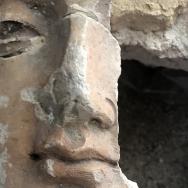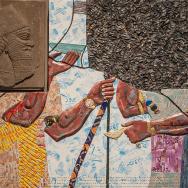Archaeologists from the Oriental Institute have helped discover a lost ancient kingdom dating to the ninth to seventh centuries B.C., which may have defeated Phrygia, the kingdom once ruled by King Midas, in battle.
In summer 2019, University of Chicago scholars and students joined an international survey team in southern Turkey to investigate Türkmen-Karahöyük, a large Bronze and Iron Age mounded settlement that was occupied between about 3500 and 100 B.C. The Konya Regional Archaeological Survey Project, directed by Michele Massa with the British Institute at Ankara, Christoph Bachhuber with Oxford University and Fatma Şahin with Çukurova University, had identified the settlement as a major archaeological site in 2017.
Last summer, a local farmer told them he’d seen a big stone with strange inscriptions while dredging a nearby irrigation canal the previous winter.
“My colleague Michele Massa and I rushed straight there, and we could see it still sticking out of the water, so we jumped right down into the canal—up to our waists wading around,” said Asst. Prof. James Osborne of the OI, one of the foremost centers of research on the ancient world. “Right away it was clear it was ancient, and we recognized the script it was written in: Luwian, the language used in the Bronze and Iron ages in the area.”
Translated by OI scholars, the pronouncement boasted of defeating Phrygia, the kingdom ruled by King Midas, legendary ancient ruler said to have a golden touch.
Osborne said it appears the city at its height covered about 300 acres, which would make it one of the largest ancient cities of Bronze and Iron Age Turkey. They don’t yet know what the kingdom was called, but Osborne said its discovery is revolutionary news in the field.
“We had no idea about this kingdom. In a flash, we had profound new information on the Iron Age Middle East,” said Osborne, an archaeologist who specializes in examining the expression of political authority in Iron Age cities.
‘A marvelous, incredibly lucky find’
Last summer, Osborne and UChicago students joined the Konya Regional Archaeological Survey Project to map the site of Türkmen-Karahöyük, located in an area littered with other famous ancient cities. Just by walking around the site’s surface, they collected bits of broken pottery from three thousand years of habitation at the site—a rich and promising find—until the farmer’s chance visit pointed them to the stone block known as a stele.
The survey team immediately identified a special hieroglyphic marking that symbolized the message came from a king. The farmer helped pull the massively heavy stone stele out of the irrigation canal with a tractor. From there it went to the local Turkish museum, where it was cleaned, photographed and readied for translation.
The hieroglyphs were written in Luwian, one of the oldest branches of the Indo-European languages. A unique language written in hieroglyphic signs native to the Turkish area, Luwian is read alternating between right to left and left to right.
While Osborne isn’t an expert in reading the Luwian language, luckily he works down the hall from two of the foremost experts in the world on Luwian: OI colleagues Petra Goedegebuure and Theo P.J. van den Hout—editors of the Chicago Hittite Dictionary.
Their translation revealed that the stele king was called Hartapu, and Türkmen-Karahöyük was probably his capital city. The stone tells the tale of King Hartapu’s conquest of the nearby kingdom of Muska, better known as Phrygia—home to King Midas. “The storm gods delivered the [opposing] kings to his majesty,” the stone read.
The OI’s linguistic analysis suggested the stele was composed in the late-eighth-century B.C., which lines up with the time that Midas ruled.
It answers a long-standing mystery, though; not quite 10 miles to the south is a volcano with a well-known inscription in hieroglyphics. It refers to a King Hartapu, but no one knew who he was—or what kingdom he ruled.
Following a longstanding tradition of OI research in the area, the survey project is already planning the next site visit, hoping to complete the survey this summer.
“Inside this mound are going to be palaces, monuments, houses. This stele was a marvelous, incredibly lucky find—but it’s just the beginning,” Osborne said.
Since its founding in 1919, the OI has conducted field-defining research across the Middle East, including excavations and field projects, linguistic research deciphering ancient languages, creating comprehensive dictionaries, reconstructing the histories, literatures and religions of long-lost civilizations, and preserving the region’s imperiled cultural heritage. Much of this research is on display at the OI Museum, located on the UChicago campus and home to the largest collection of ancient Middle Eastern artifacts in the United States with 350,000 objects. Learn more at the OI centennial website.
Editor’s note: The Konya Regional Archaeological Survey Project takes place with the kind permission of Turkey's Ministry of Culture, and KRASP is grateful for their support. This story appearing on UChicago News is authorized according to Ministry of Culture regulations. For further information, please contact the Turkish Ministry of Culture.

